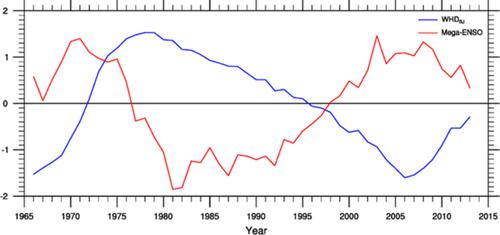当前位置:
X-MOL 学术
›
Atmos. Sci. Lett.
›
论文详情
Our official English website, www.x-mol.net, welcomes your
feedback! (Note: you will need to create a separate account there.)
Interdecadal relationship between the wintertime haze frequency over Beijing and mega‐ENSO
Atmospheric Science Letters ( IF 2.0 ) Pub Date : 2020-08-17 , DOI: 10.1002/asl.1007 Jing Wang 1 , Yanju Liu 2 , Yihui Ding 2
Atmospheric Science Letters ( IF 2.0 ) Pub Date : 2020-08-17 , DOI: 10.1002/asl.1007 Jing Wang 1 , Yanju Liu 2 , Yihui Ding 2
Affiliation

|
Observational analyses suggest that natural or internal climate variability plays a crucial role in modulating wintertime haze days in Beijing (WHDBJ) on decadal timescales, which may overwhelm the effect of human emissions to some extent. This study links the variations in WHDBJ to the mega‐El Niño–Southern Oscillation (ENSO), a newly defined ENSO‐related pattern with a vaster range of variability, on decadal timescales. The mega‐ENSO delineates an apparent out‐of‐phase relationship with WHDBJ, which could be used to explain past and recent decreases in WHDBJ in 1961–1971 and 1997–2012, as well as the increase in WHDBJ in 1972–1996. The positive phase of the mega‐ENSO can induce a high dynamical scavenging efficiency of pollutants over the Beijing area through notable in situ low‐level northerly wind anomalies that are associated with a quasi‐barotropic anticyclonic anomaly centered around Lake Baikal, thus reducing the frequency of haze days on decadal timescales, and vice versa for the negative phase. The mega‐ENSO can influence interdecadal predictions of the long‐term occurrence of haze events over Beijing. Therefore, it will be focused upon in future routine operations.
更新日期:2020-08-17











































 京公网安备 11010802027423号
京公网安备 11010802027423号